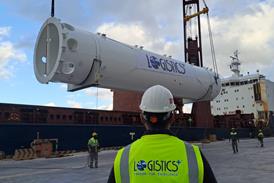January 27 - A pair of bridge placement contracts has shown the sort of strategic heavy-lift, transport and installation services that UK-based ALE is capable of.
The company recently provided a successful solution for the replacement of a railway bridge in Liverpool, UK.
The 500 tonne old bridge decks adjoined to Liverpool Sandhills Station were removed using 28 axles of SPMTs. ALEintegrated 16 100 tonne capacity climbing jacks into the transport arrangement, to ensure height requirements over the abutment wall.
To complete the project the old and replacement bridge decks had to be manoeuvred around the station platform and beneath a temporary walkway bridge. ALE used various configurations of SPMTs to achieve the limited space manoeuvres, and also had to ensure that no loading was applied to the small section of pavement that needed to be crossed, which was achieved by transporting them across bridging mats. The decks were then offloaded to high level trestles where they would then be jacked down for demolition (pictured below).
The 270 tonne replacement bridge decks which were previously jacked up to installation height in preparation were removed from the trestles using 16 axles of SPMTs and a climbing jack system.
Meanwhile, in Canada, the company has successfully installed two parallel bridges spanning the 1.5 km width of the Beauharnais canal.
The steel bridges each weighing 7,100 tonnes, were positioned using ALE's skid system, and will be part of the new highway 30 in Quebec, Canada.
The bridges were skidded out using 300 tonne capacity jacks; and ALE says the skid system was the most suitable for this project because of the effectiveness and accuracy when moving such big pieces.
ALE also installed a recovery deflection system consisting of a mast linked by steel wires to the structure using two 850 tonne capacity strands jacks.
Each bridge had an auxiliary launching nose of 20 m in order to minimise the cantilever and provide a stable operation. Each bridge was launched across the 19 bridge piles which were mostly 82 m apart with the execption of the commercial crossing section of the canal which was 160 m between piles, in addition ALE engineers had to consider a three percent incline.
Harsh winter weather meant that ALE took measures to ensure the safety of employees, and performance of equipment, by adaptations such as the use of special steel for higher impact resistance.
















